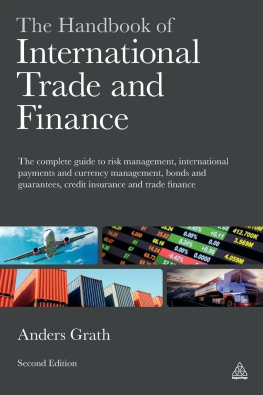Preface
The idea for writing a book on my favorite subject came to me after I had taken my CDCS exam in 2014. I chose to write a book on a subject like letter of credit because of my love for the subject and also keeping in mind my own struggles while I was preparing for the exam. The thought of generating interest in trade finance professionals for letter of credit motivated me to write this book. The book gives a brief description of trade finance, types of letters of credit, explanation of the 39 articles of UCP 600 followed by a questionnaire to test the understanding of the reader and a glossary.
The journey of writing this book was not free of hiccups as being a professional I was most of the time occupied by work. The fact that I had written a book on this subject landed me a job in my current organization. But before I could give it for publication, I went out of country for professional reasons. After I came back, I decided to go after my dream and I started working on my book again. With the grace of almighty God, finally this book is being published and I hope that it would be liked by the readers. My sincere apologies in advance for any unintentional mistakes in the text.
Nisha Koshal


Notion Press
Old No. 38, New No. 6
McNichols Road, Chetpet
Chennai - 600 031
First Published by Notion Press 2017
Copyright Nisha S Koshal 2017
All Rights Reserved.
ISBN 978-1-946822-08-6
This book has been published with all reasonable efforts taken to make the material error-free after the consent of the author. No part of this book shall be used, reproduced in any manner whatsoever without written permission from the author, except in the case of brief quotations embodied in critical articles and reviews.
The Author of this book is solely responsible and liable for its content including but not limited to the views, representations, descriptions, statements, information, opinions and references [Content]. The Content of this book shall not constitute or be construed or deemed to reflect the opinion or expression of the Publisher or Editor. Neither the Publisher nor Editor endorse or approve the Content of this book or guarantee the reliability, accuracy or completeness of the Content published herein and do not make any representations or warranties of any kind, express or implied, including but not limited to the implied warranties of merchantability, fitness for a particular purpose. The Publisher and Editor shall not be liable whatsoever for any errors, omissions, whether such errors or omissions result from negligence, accident, or any other cause or claims for loss or damages of any kind, including without limitation, indirect or consequential loss or damage arising out of use, inability to use, or about the reliability, accuracy or sufficiency of the information contained in this book.
Chapter 3
Issuance of Letter of Credit
In the earlier chapter we had studied about letter of credit as a method of payment and other types of credits. This chapter will focus on the issuance of a documentary credit. After the conclusion of the sales contract, and selection of letter of credit as a method of payment, it is the buyers responsibility to request issuance of documentary credit and dual responsibility of seller and buyer to agree on the contents of the documentary credit as stated in the sales contract. The content should give details about how the credit is to be issued. Banks, mostly issue letters of credit on behalf of customers with whom they have a long standing or established relationships but in current scenario and growing business needs, letters of credit are also issued on behalf of new clients. Since its the issuing bank which gives its irrevocable undertaking to honor a complying presentation, it is important that the issuing bank is able to obtain reimbursement/settlement from the importer. Banks provide facility (non fund based limits) to its customers against some collateral. Sometimes banks also issue letters of credit by either keeping 100 pct cash margin or a certain pct of the credit amount in the form of a fixed deposit. The banks must ensure that such fixed deposits are lien marked so that the applicant does not get it liquidated. Again it depends upon the sanctions/limits provided to the applicant that what should be the percentage of cash margin. The buyer submits to the issuing bank:
- A letter requesting the issuance of documentary credit, also giving the bank the authority to debit its account for charges and margin. The applicant also agrees to reimburse the issuing bank at the time of payment.
- A letter of credit application form.
- 100rs non judicial stamp paper (Indian banks take).
- Pro forma invoice/confirmed purchase order.
- Insurance document (depending on the incoterm) having the name of the issuing bank.
The buyer and seller should agree to the following points relating to the issuance of letter of credit in order to avoid any problem that may arise at document examination stage:
 Validity, expiry date and expiry place.
Validity, expiry date and expiry place. Whether the credit is to be available by sight, acceptance, negotiation or deferred payment.
Whether the credit is to be available by sight, acceptance, negotiation or deferred payment. The bank with which the credit is to be available.
The bank with which the credit is to be available. The currency and amount of credit.
The currency and amount of credit. Whether partial shipment is allowed.
Whether partial shipment is allowed. Whether transshipment is allowed.
Whether transshipment is allowed. Which type of transport document will be applicable.
Which type of transport document will be applicable. The incoterm that will be applicable and depending on it the insurance requirements.
The incoterm that will be applicable and depending on it the insurance requirements. How the goods are to be described.
How the goods are to be described. What all documents are required.
What all documents are required. Who will pay the respective bank charges.
Who will pay the respective bank charges. Which bank will act as the advising bank.
Which bank will act as the advising bank. Whether the credit is to be confirmed and who will bear the confirmation charges.
Whether the credit is to be confirmed and who will bear the confirmation charges. Depending upon the credit requirement whether to nominate a reimbursing bank.
Depending upon the credit requirement whether to nominate a reimbursing bank. Whether the credit is to be issued as transferable.
Whether the credit is to be issued as transferable.
Some Important Points to be Noted
The transport document to be called should be according to the modes of transport that are likely to be utilized.
The documents to be presented by the beneficiary should be very clearly mentioned in order to avoid any disputes later.
Next page











 Validity, expiry date and expiry place.
Validity, expiry date and expiry place.